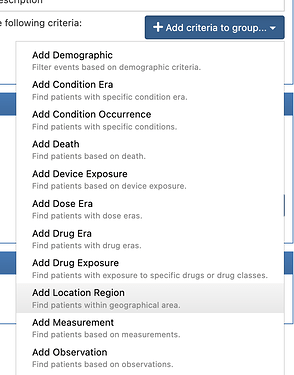Yes, but not using that concept. and Location concepts are only used in very specific places: either Visit or VisitDetail criteria, using the ‘PlaceOfServiceLocation’ attribute:
Some notes:
this attribute was marked CDM >=6.1 which means it was implemented expecting that there would be a CDM 6.0, but that has been suspended. However, if it was backfilled to CDM 5.4, then it is something that will work on your database. You’d have to check if you have a LOCATION and LOCATION_HISTORY table in your CDM, and if your CARE_SITE table has records that associate a VISIT to CARE_SITE, and then a join between CARE_SITE CS and LOCATION_HISTORY LH where LH.entity_id = CS.care_site_id and LH.domain_id = “CARE_SITE” and the Visit start date falls between the LOCATION_HISTORY’s start and end date.
They made Location history pretty complicated, so it might take a little futzing to know if you know if your data is set up to use locations, but, if it is, then you can look for PlaceOfServiceLocation of Visit/VisitDetail using those location concepts. Locaton concepts in vocabulary are hierarchal, so you can go to something like Country->state->county using concept set expressions.
Btw: from your screenshot, I don’t think that concept is exactly a location region, but rather a concept that represents a ‘state’. You don’t need that concept but rather the concepts that represent location concepts in the vocabulary.
@clairblacketer , please confirm if LOCATION and LOCATION_HISTORY is actually part of CDM 5.4. If not, then the answer to the above is ‘no, you can’t use location concepts in atlas’.



